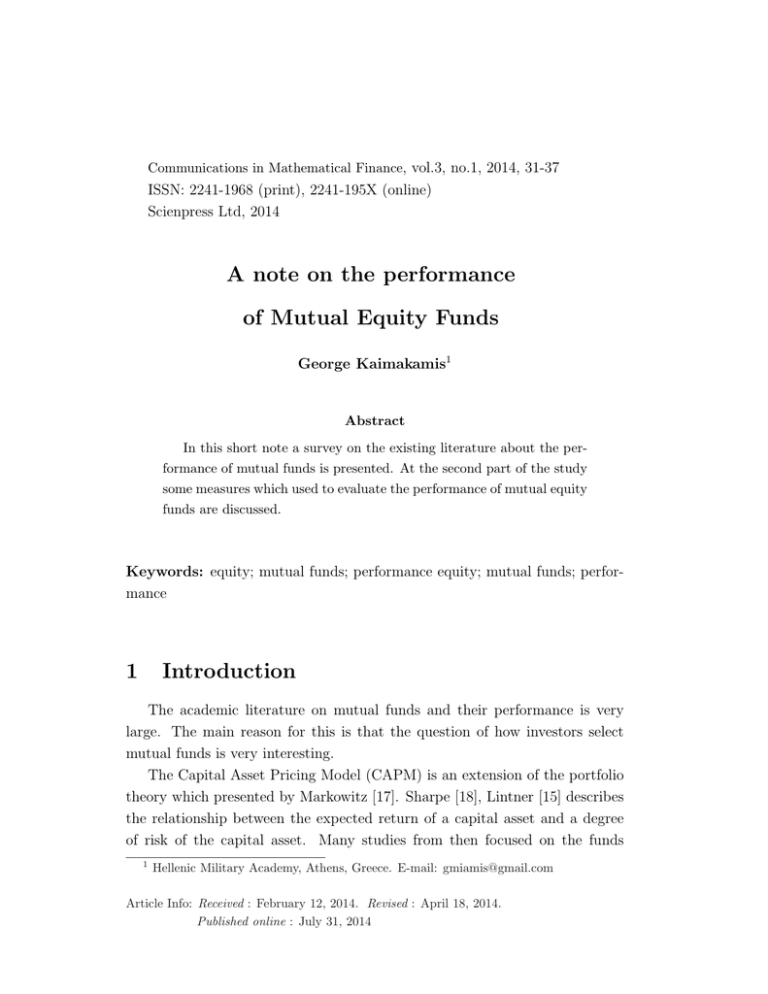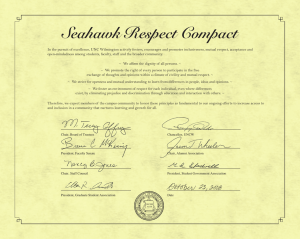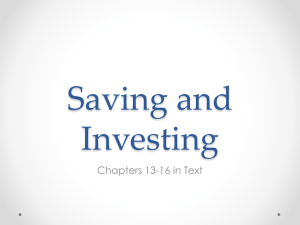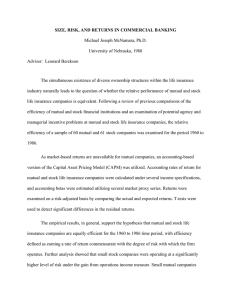A note on the performance of Mutual Equity Funds
advertisement

Communications in Mathematical Finance, vol.3, no.1, 2014, 31-37 ISSN: 2241-1968 (print), 2241-195X (online) Scienpress Ltd, 2014 A note on the performance of Mutual Equity Funds George Kaimakamis1 Abstract In this short note a survey on the existing literature about the performance of mutual funds is presented. At the second part of the study some measures which used to evaluate the performance of mutual equity funds are discussed. Keywords: equity; mutual funds; performance equity; mutual funds; performance 1 Introduction The academic literature on mutual funds and their performance is very large. The main reason for this is that the question of how investors select mutual funds is very interesting. The Capital Asset Pricing Model (CAPM) is an extension of the portfolio theory which presented by Markowitz [17]. Sharpe [18], Lintner [15] describes the relationship between the expected return of a capital asset and a degree of risk of the capital asset. Many studies from then focused on the funds 1 Hellenic Military Academy, Athens, Greece. E-mail: gmiamis@gmail.com Article Info: Received : February 12, 2014. Revised : April 18, 2014. Published online : July 31, 2014 32 A note on the performance of Mutual Equity Funds performance in terms of risk, return, timing etc. Sharpe [19] studied the annual rates of return of mutual funds in relation to the risk involved for two periods 1944-1953 and 1954-1963. On the other hand Jensen in [13] studied the performance of mutual funds for the period from 1945-1964. Friend et al. studied 136 mutual funds for the period from 1960 to 1968, and they found that the rates of return of the mutual funds were not better than random equally shared portfolios, [6]. In [5], Firth studied 360 mutual funds of England for the time period 1965 1975. Grinblatt and Titman (1992) study US equity funds between 1974 and 1984, [8]. They consider two periods of five years and estimate the alpha of each fund over these two periods. Huij and Derwall [12] used a three-factor model to measure the performance of 3500 bond funds from 1990 to 2003. A number of studies find evidence that stock selection ability persists over periods as short as one year. These studies find that although funds on average generate negative abnormal returns, relative performance persists. Persistence studies include Hendricks [10], Goetzmann and Ibbotson [7] , Hereil and Mitaine [9] etc. Various researchers, such as, Elton [2], Brown and Goetzmann [8], Hendricks et al. (1993), Engen and Lehnert [3], conducted studies on the rates of return of mutual funds. Some of those studies detect selectivity and market timing abilities, for example Treynor and Mazuy [20], Henriksson and Merton [11]. According to Treynor and Mazuy [20], market timers, being able to forecast market returns, will increase (decrease) their holdings of the market portfolio when the return on it is high (low). As a result, they proposed a procedure for detecting timing ability that is based on a regression analysis of the managed portfolios realized returns, which includes a quadratic term. Lately some researchers used bootstrap techniques on their study. These techniques allowed the use of the non-normality in the idiosyncratic risks of the funds, [16]. They used models to test persistence and for the regression models they define time varying parameters. 33 G. Kaimakamis 2 2.1 Measures of Performance Morningstar rating system The first rating system was developed in 1985. It called Morningstar rating system. This rating is quantitative and is based on past performance. Each fund is assigned a rating from one to five stars, based on its risk-adjusted performance measure (RAPM). We use the utility function: w−γ U (w) = γ where w is the investors wealth and γ > 0 is the parameter which describes the intensity of the investors risk aversion. By R, we denote the monthly excess return of the fund over the risk-free rate. The certainty equivalent excess return RCE is defined U (1 + R)CE = E[U (1 + R)] If we solve this equation we deduce that: 1 RCE = E[(1 + R)−γ ]− γ − 1 Then we use a Taylor expansion of the last equation in order to illustrate that RCE is effectively a risk-adjusted performance measure as follows: RCE = E[R] − γ(γ + 1)E[R2 ] + · · · The risk-adjusted performance measure, called the Morningstar risk-adjusted return (MRAR), is then the estimate of the certainty equivalent excess return RCE : 12 1 M RAR = [ (1 + Rt )−γ )]− γ − 1 T where T is the number of observations and Rt is the excess return of the fund at month t. 2.2 Treynor and Sharpe ratios The Treynor ratio is the first risk-adjusted performance measure of mutual funds and it was popularized by Treynor in 1965. It is calculated as the ratio 34 A note on the performance of Mutual Equity Funds of excess return of the mutual fund divided by the beta (systematic risk) of the fund and it is defined: RP,t − Rf,t β Sharpe ratio was developed by Sharpe, [18], [19]. In Sharpe ratio, β is replaced by the standard deviation of the fund, which is a measure of its risk. Treynor ratio is similar to the Sharpe ratio with the difference being that the Treynor ratio uses as the measurement of volatility, and it is defined RP,t − Rf,t σ where σ denotes the standard deviation. The advantage of using the Sharpe ratio to evaluate portfolios is that it is directly computable and it is not relate to a certain market index. 2.3 Other models (regressions) The monthly rates of return of the mutual funds denoted by Rp,t and calculated via the formula: Pi,t Rp,t = log Pi,t−1 where Pi,t is the value of the equity fund i at the end of the time period t and Pi,t−1 is the value at the end of the time period t − 1. In [19], Sharpe proposed one factor pricing model named Capital Asset Pricing Model (CAPM) by: E[Ri ] = Rf + βi (E[Rm ] − Rf ) where Rm is the return of the market portfolio and βi is the measure of the systematic risk defined: cov(Ri , Rm ) βi = var(Rm ) In [13], Jensen proposed a model to measure the performance of mutual funds by estimation of CAPM using the regression Ri,t − Rf,t = αi + βi (Rm,t − Rf,t ) + ui,t where ui,t is independent and satisfies E[ui,t ] = 0 and ui,t = σi2 . The term αi is named Jensens alpha and it measures the abnormal performance of mutual G. Kaimakamis 35 funds. In particular, Jensen considers that a significantly positive indicates that the manager of the fund has an ability to forecast stock prices. In [20], Treynor and Mazuy use the following regression to test for selectivity and market timing: Rp,t − Rf,t = α + β(Rm,t − Rf,t ) + γ(Rm,t − Rf,t )2 + et where Rp,t − Rf,t is the excess return of the portfolio p on time t, Rm,t − Rf,t is the excess return of the market, α is the estimated selectivity performance, β is the portfolios estimate of systematic risk, γ is the estimated indicator of market-timing performance and et is the residual excess return on portfolio p during period t. Market timing skills relate to the ability of fund managers to correctly assess the direction of the market, either bull or bear, and position their portfolio accordingly. Selectivity skills refer to the capabilities of fund managers in generating superior performance by means of stock selection techniques. The Treynor and Mazuy model implies that the value will be positive and significant if the fund managers have high selectivity skills. Also, a positive and significant market timing coefficient value γ implies superior market timing abilities of fund managers. An insignificant value for γ can be interpreted either as a lack of timing ability or as no attempt by a fund manager to time the market as is the case in a buy or hold strategy, [1]. Fama et al in [4] proposed a three factor-model E[Ri ] − Rf = βim (E[Rm ] − Rf ) + βisb E[Rsb ] + βihl E[Rhl ] where Rsb is the return of small stocks minus the return of large stocks and Rhl is the return of stocks with high book-to-market values minus the return of stocks with low book to market values. References [1] Alexandros Koulis, Christina Beneki, Maria Adam and Charalampos Botsaris, An Assessment of the Performance of Greek Mutual Equity Funds Selectivity and Market Timing, Applied Mathematical Sciences, 5(4), (2011), 159-171. [2] Elton E.J., Gruber M.J. and Blake C.R., The Persistence of risk-adjusted Mutual Fund Performance, Journal of Business, 69, (1996a), 133-157. 36 A note on the performance of Mutual Equity Funds [3] E.M. Engen and A. Lehnert, Mutual Funds and the U.S. Equity Market, Federal Reserve Bulletin, 86(12), (2000), 797-812. [4] Fama E.F. and French K.R., Common Risk Factors in the Returns on Stocks and Bonds, Journal of Financial Economics, 33(1), (1993), 3-56. [5] M. Firth, The investment performance of unit trusts in the period 1965 1975, Journal of Money, Credit and Banking, 9, (1977), 597-604. [6] Friend, M. Blume and J. Crockett, Mutual Funds and Other Institutional Investors: A New Perspective, McGraw-Hill Book Co, New York, 1970. [7] Goetzmann W. and Ibbotson R. (1994), Do Winners Repeat? Patterns in Mutual Fund Performance, Journal of Portfolio Management, 20, 9-18. [8] Grinblatt M. and Titman S., The Persistence of Mutual Fund Performance, Journal of Finance, 47, (1992), 1977-1984. [9] Hereil, Pierre and Mitaine, Philippe and Moussavi, Nicolas and Roncalli, Thierry, Mutual Fund Ratings and Performance Persistence, (June 25, 2010). Available at SSRN: http://ssrn.com/abstract=1749414 or http://dx.doi.org/10.2139/ssrn.1749414 [10] Hendricks, D., J. Patel, and R. Zeckhauser, Hot Hands in Mutual Funds: Short-Run Persistence of Performance, 19741988, Journal of Finance, 48, (1993), 93-130. [11] R.D. Henriksson and R.C. Merton, On the Market Timing and Investment Performance of Managed Portfolios II-Statistical Procedures for Evaluating Forecasting Skills, Journal of Business, 54, (1981), 513-533. [12] Huij J. and Derwall J., Hot Hands in Bond Funds or Persistence in Bond Performance, Journal of Banking and Finance, 32, (2008), 559-572. [13] M. Jensen, The performance of mutual funds in the period 1945-1964, Journal of Finance, 23, (1968), 389-416. [14] I. Kosowski R., Timmermann A., Wermers R. and White H. Can Mutual Fund Stars Really Pick Stocks? New Evidence from a Bootstrap Analysis, Journal of Finance, 61, (2006), 2551-2596. G. Kaimakamis 37 [15] J. Lintner, The Valuation of Risk Assets and Selection of Risky Investments in Stock Portfolios and Capital Budgets, Review of Economics and Statistics, 47, (1965), 13-37. [16] I. Mamaysky H., Spiegel M. and Zhang H., Improved Forecasting of Mutual Fund Alphas and Betas, Review of Finance, 11(3), (2007), 359-400. [17] H. Markowitz, Portfolio Selection, The Journal of Finance, 7(1), (1952), 77-91. [18] W.F. Sharpe, Mutual Fund Performance, Journal of Business, 39, (1966), 119-138. [19] W.F. Sharpe, Capital Asset Prices: A Theory of Market Equilibrium Under Conditions of Risk, Journal of Finance, 19, (1964), 425-442. [20] J. Treynor and K. Mazuy, Can Mutual Funds Outguess the Market?, Harvard Business Review, 44, (1966), 131-136.







